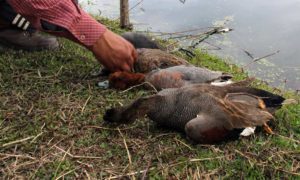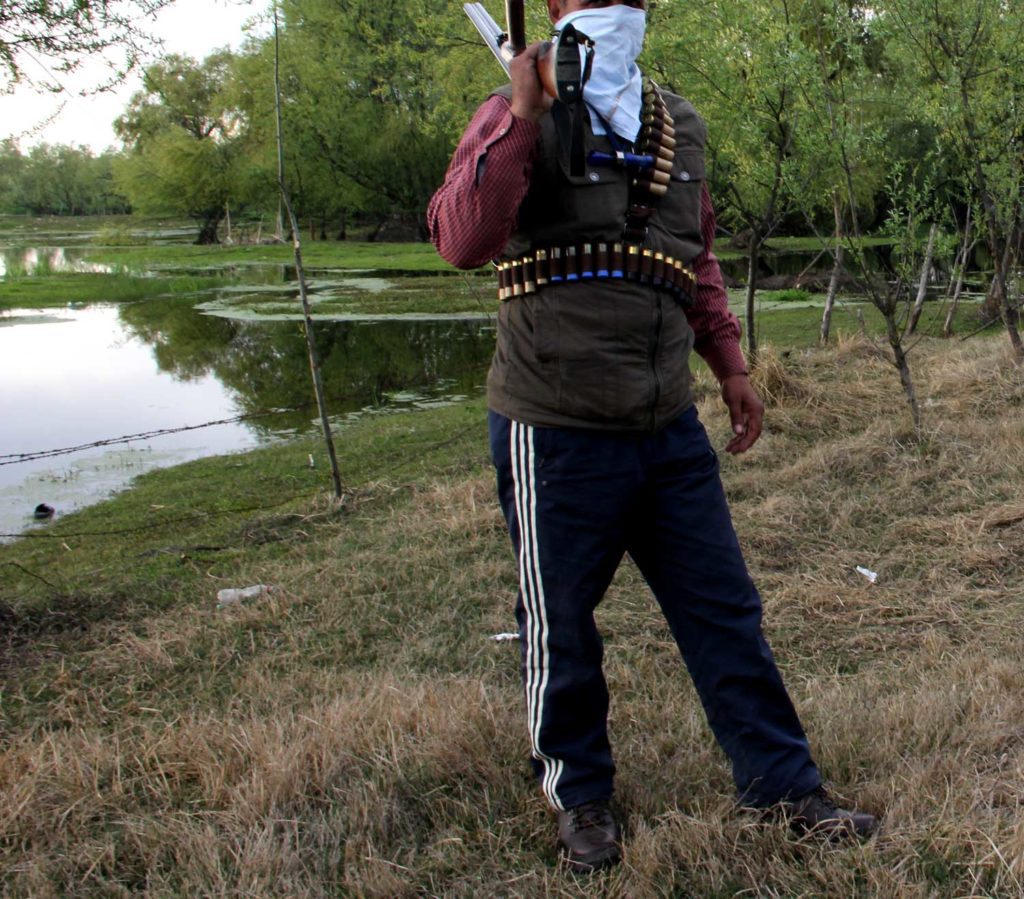After reporting evidences on unbridled poaching inside Kashmir wetlands, Free Press Kashmir has now come up with revelations of the nexus in the ranks of wildlife department. Among other things, the follow up reveals how the official patronage is encouraging culling of the guest birds, en masse.
As gunshots rang up inside Hokersar wetland in a nippy day of February 2017, an in-charge forester of Hokarsar, Imtiyaz Wani rushed out of his office to access the situation. As he ran towards the firing spot, he found one Ghulam Rasool Dar holding a smoking gun. Some small distance away, near wild bushes, his prey lay lifeless.
Dar, the felon, was a casual labourer at the Hokersar office.
The scene unsettled Wani. He tried to arrest the predator in his ranks, but got a sound beating from the armed offender instead. While Wani was being beaten up, his colleagues stood watching, like “sadist spectators”.

But the whacking didn’t discourage him to file an application for FIR against Dar under the JK Wildlife Protection Act 1978. Amended in 2002, the Act makes poaching an offence and hand over a three years imprisonment or a fine of up to Rs 25,000, or both to an offender.
With Dar yet to be convicted, many say, much of the impunity for such felony comes from within the department.
“No such event has been recorded,” Abdul Rauf Zargar, Wildlife Warden Hokarsar, shrugged off the episode.
ALSO READ: Following a poacher in the heart of Kashmir’s wetlands
But that day in February, Dar wasn’t caught red-handed for the first time. His track-record speaks for him. Already named in series of FIRs, Wani says, he hasn’t faced the law till date.
“I fail to understand what sort of backing does this casual laborer enjoy,” Wani asked, as we sat to talk inside his office amid the pervasive hush over Hokersar, the largest wetland reserve in Kashmir, spread over 13.75 square kilometers.
“No empowered authority is able to take action against him,” he continued. “I mean, how has he been bailed out and not even terminated? The department should slap a Public Safety Act on him to make an example of such an incorrigible offender.”
But there’s a reason why people like Dar are still calling the shots with impunity.
Some elements in the department, said Tariq Ahmad, the state president of Wildlife Association, are creating hurdles to punish such offenders.
The affirmation makes it certain that patronized poachers like Dar—otherwise having a field day to poach the migratory birds—exist in plenty in the department. Infact, a fact-finding and eyewitness account reveal that these poachers visit the wetland in wee and evening hours.
“On an average,” claimed a wildlife official, having a reputation of a silenced whistle-blower, “these poachers kill around 900 birds per day.”

Interestingly, before becoming a trend in recent years, the poaching had gone down during the initial period of militancy.
But as ‘improved situation’ helped poaching to make a comeback, even the Indian army would exhort Kashmiris to “prevent poaching of the beautiful migratory birds coming from faraway lands” in its organized seminar ‘Preservation of Wetland and Migratory Birds’ on Dec 1, 2016.
However, even the army’s campaign couldn’t prove a deterrent in this case.
Already, police’s puny action has been viewed as the biggest handicap in the entire poaching enterprise where some ‘elites’ are hunting with pleasure. This makes many feel that in a conflict-zone like Kashmir, otherwise trending for different news, the bird welfare isn’t a priority for the law-enforcing agencies.
Some irregular raids inside wetlands aren’t helping either. Poachers continue to give a slip to the police, leaving behind their guns. Even detention doesn’t seem to help as the offenders manage to get an easy bail. The trend has already created ugly results.
Despite record number of migratory birds arriving in Hokersar and other Kashmir wetlands earlier, the number of species has reportedly gone down over the years.

Migratory birds start arriving in the first week of November as Kashmir presents them a comparatively hospitable alternate habitat compared to the extreme freezing conditions in their natural habitats of Central Asia and Europe.
Already this year, over 3 lakh birds—including Mallards, Shoveler, Wigeon, Grayleg Goose, Common Teal, Northern Pintail, Coot, and others—have arrived in Kashmir. The number is likely to rise by the first week of February, when the concentration of migratory birds peaks.
These birds spend almost five months in Kashmir wetlands. This is the time period, between November and March, when poachers hunt in packs.
“In poachers’ glossary,” says Sultan, a wildlife official, “that 5-month period is the hunting season.”
Amid the free run of poachers, the wildlife department cites paucity of “manpower and equipment” to act. Even the squads they’ve set up to maintain vigil around the wetlands of Kashmir doesn’t seem to help—as poachers have reportedly turned Hokersar, Hygam, Shallabugh, Mirgund and many other wetlands into hunting havens.
The locals around these wetlands even confirm the broad day light poaching “in connivance with the department”. These locals, mostly birdwatchers, say poachers have turned these wetlands into a death trap for migratory birds.
They now fear that the unabated hunting might affect the inflow of the birds in coming years.
But sadly, the story of poaching does not end here.
Besides the high market demand of the migratory birds like greylag goose, the poachers are also pushing eggs of these migratory birds into the market.
In the bylanes of Amira Kadal’s Goni Khan, I found some odd eggs among the regular ones placed in a wicker basket of a street-side seller. He revealed that those were eggs of a migratory water bird, called Quail.
“We collect these eggs from the interiors of Hokersar,” said the shy-seller. “Sometimes, we buy them from persons regularly visiting wetlands for hunting.”

For many Kashmiris relishing the ‘bird meat’ since long now, this might not be any revelation, but the worry remains how the unchecked practices has now threatened to dent the stable wetland ecosystem.
On their part to curb poaching, “authorities” had directed licensed gun holders in the 5-km radius of famous wetlands including Hokersar to deposit their weapons with the concerned police stations. But even then, some traditional practices continue to make poaching a rampant menace.
In many villages around the wetland, poachers resort to a kind of snarl placed in the water to catch the birds alive. This, amid smoking guns, makes Wani, the in-charge forester at Hokersar, to assert, “its bird butchery happening inside Kashmir wetlands.”







